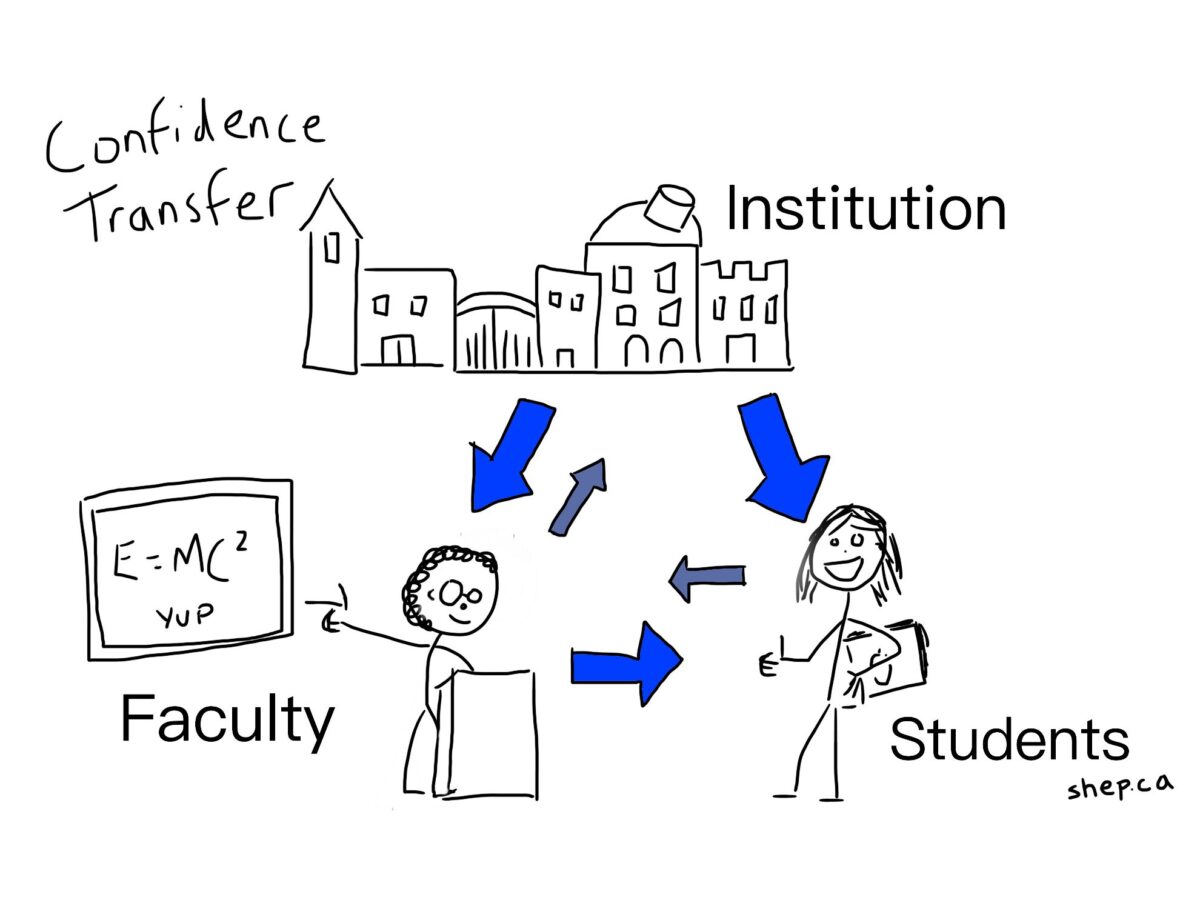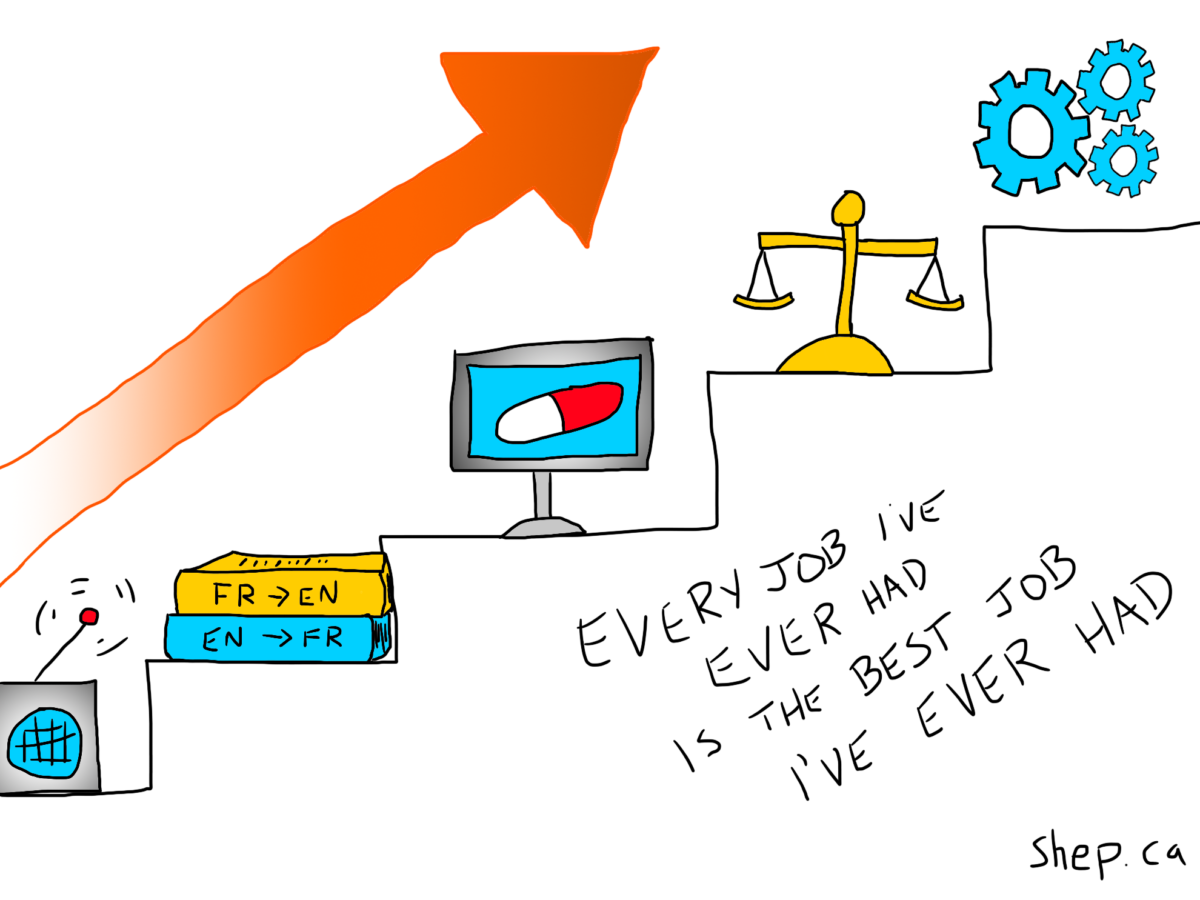What does it mean when every job you’ve ever had is the best job you’ve ever had?
Because that’s the deal. I think I’m just an incredibly fortunate dude.
In high school I had the usual slate of jobs — gas station, washing dishes at a restaurant, busboy, hardware clerk at Canadian Tire (if a teenager working at the Tire ever tells you he knows what he’s talking about, believe me he does not).
The first ‘real’ job, though — like actual responsibility, opening and closing, managing a float, dealing with customers solo — was at a used book / comic book / trading card shop called Twice Told Tales. The owner, Ron, was a great guy and pretty much the ideal boss for a 15- or 16-year-old. He was probably in his early thirties then, but was an adult to me, in that way everyone over 25 is “generic adult”. He had another store in Markham he spent a lot of time at, so I kind of semi-managed it after a year — buying books, taking stock, putting in orders, running inventory, managing the cash and the float. I loved books and comic books and in my last year there, Magic the Gathering cards. I discovered Richard Brautigan and alternative ‘comix’ there.
It was the best job I ever had.
Graduating from Ryerson and the Radio & Television Arts program, I somehow lucked into being the editor in chief of the school paper, the Eyeopener — one of only a handful of non-journalism grads to do it. I drank a lot of coffee and smoked cigarettes and had yelling fights with the news editors and the photo editors sometimes. We ran me for office in the provincial election in the Fort York riding as a publicity stunt (positioning ourselves as the Spider-Sense Revolution, in opposition to Mike Harris’ Common Sense Revolution, with a general mandate to do all-candidates meetings and talk about how education matters) and I got 140 votes, which wasn’t great but still beat the Natural Law party and the Marxist-Leninists. Production nights — this was in the era of pasteup, where we would lay out the paper on Macs but still had to print everything and paste it up on waxed board, making edits with blue pencils and cutting out and replacing individual words and letters with Xacto knives — would go on till about two in the morning, and a few of us would crash on the office couches to get up and deliver the paper at 5 a.m. the same day. We ate bad Chinese food and terrible pizza. When the stars aligned, we’d get ads from both the local Caribbean restaurant Mr. Jerk and for a sperm donor clinic which we would dutifully place next to each other on the back page of the paper. Mike, one of our news editors, once stole three bags of shredded papers from the Principal’s trash after a closed-door budget meeting and spent a whole night trying to tape them back together. Somebody sent us a Sega Saturn for the entertainment section and we stayed up all night playing Virtua Fighter. We launched a whole new section of the paper, championed and edited by Brian Daly, called Roots & Culture because even in 1995 it was sadly obvious that everything was too white and marginalized people needed voices. I worked with brilliant people who later became luminaries in journalism and graphic design — Ed Keenan, Doug Cudmore, Stefan Woronko.
It was the best job I ever had.
As my time at the Eyeopener was drawing to a close, I got a call from my friend Mark who told me that the radio station at the 2000-student English-language university he went to in Quebec — Bishop’s — had just gotten its FM license. But the CFRC said they had to have a full-time station manager and their total budget was around $14,000 a year so they needed somebody who would work for about the equivalent of $5 an hour to run a radio station. I leapt at the chance and they hired me. I was the only full-time employee of a station that at its peak was broadcasting in four languages, with over two hundred volunteers manning shows from 6 a.m. to 2 a.m., seven days a week. The volunteers were all dedicated and a bit crazy; some of them formed a record label later, which among other things was the first to sign Canadian indie rock darlings The Dears. We hosted cheap concerts for bands who just wanted a place to crash and a share of the door on runs from the East Coast to Montreal. I made spaghetti and meatballs for The Planet Smashers and Itch crashed on my sofa once. The station went from 25 watts to 500, broke from the student union and became an independent non-profit, and did some ridiculously innovative things in radio programming that I’m proud of today.
It was the best job I ever had.
After some time kicking around cleaning apartments and helping run a B&B, I was hired to be the editor for a truly brilliant guy who was doing French-to-English translation but needed an editor to turn his translated English back into “English English.” It was a great idea and one I generally don’t see many translators use. I started with him part-time, then full-time, and after a few years it was a standalone office and four full-time staff. We did tons of work for ad agencies, government work, tourism, all kinds of things. We translated a liquor catalogue for the SAQ and that’s how I learned “cat piss” is a legit tasting note for wine. Also that deaths in pharmaceutical studies are “serious adverse events.” My love for language deepened and my boss, Scott, patiently and insistently drilled into me a rock-solid attention to detail that was not part of my DNA but now reverberates in my bones.
It was the best job I ever had.
One of our clients was an ad agency that was doing boutique work out of Sherbrooke, and needed a lot of help with English-language content because they’d started doing original creative for national brands — Bayer, Johnson & Johnson — that wanted standalone Quebec marketing, but that in turn needed to be translated into English for the Quebec English market. Also loads and loads of translation for pharma studies, because the Université de Sherbrooke was a hospital school and there were drug trials stacked a mile deep there. I was the “creative guy” and they eventually crunched the numbers and realized it was cheaper to hire me than to keep hiring the company, so they offered and I accepted. I was the twelfth hire at the agency. Eight years later it was 52 people, and doing national campaigns for international brands, instead of the Quebec versions; holding down marketing for major pharmaceutical companies and making a name in the burgeoning area of animal health. The graphic designers – Dan, Charles, Charlie, Val, Élizabeth – were (and are) stone cold brilliant, and working with them was pure alchemy. Living in an environment where we transitioned from French to English and back seamlessly according to which word felt the most right at the moment was a joy. The account directors were driven but compassionate, and the owner had a rock-solid dedication to quality of life that was the envy of every other agency we ever met. I got to sit down with clients at the outset of mandates, pitch our work, and carry it to execution with our creative team. It was fits of boundless brilliance punctuated with camaraderie and discovery. I could spend three weeks immersed in swine vaccines, come up for air, and find myself learning every intricacy of the paperboard industry to launch a company, and then leap into developing patient adherence materials for a novel chemotherapy regimen.
It was the best job I ever had.
For a variety of reasons, Quebec stopped feeling like home, and when I looked for work, I was lucky enough to find Queen’s Law. I wasn’t going to apply but Mike — from the Eyeopener, and the shredded papers, remember? — was working there and said I totally should. So I did. I became the first director of marketing & communications at the school’s law faculty, despite not knowing a thing about law. From there, I got to grow a team that included alumni and advancement staff to turn it from a modest law school with no digital presence to arguably the most online law school in Canada. I got to expand from marketing and communications to alumni and advancement (university fundraising, for the uninitiated) work. Rare for higher ed, I got to see the full scope of our lifecycle, from the first outreach to high school students to alumni 50+ years out. We built a wildly successful national online undergraduate program in law, reinvented alumni communications, rebuilt our entire web presence, and became polyvalent storytellers on almost every channel we could get our hands on. I delved into research promotion with Canada’s finest legal scholars, and could spend a day rocketing from working on brand development for our pro bono clinics to structuring a Constitutional Law book launch, and develop a fundraising proposal for a new chair in business law over lunch. I learned that law is the secret lever that moves the world: that no matter what you do and where you go, if you live in society, law is the steady thrum that holds all of civilization together. The faculty are staggeringly brilliant, but so were the staff — and the students, who I admittedly had a lot of “law student” stereotypes about, were and are the most considerate, thoughtful, passionate and driven people I’ve ever met.
It was the best job I ever had.
Until four hours ago.
I’ve just put a pin in Queen’s Law, and starting tomorrow I’m officially the Director of Marketing and Communications at Queen’s Faculty of Engineering and Applied Science. On paper it’s a lateral move, but as somebody who’s never made a choice based on titles or money, it’s a creative step into a thrilling unknown. It’s going to broaden my scope from law (which is itself a cosmos) to a dizzying array of sciences I can barely wrap my head around. I’m working with the people who build, and rebuild, the world. It’s the crackling excitement of students testing the frontiers of what they’re capable of, in Tony Stark labs with genius mentors urging them on. It’s reactors and robots and biomechanics and chemistry. It’s the technology that’s going to improve our lives, and possibly save them all. It’s literally the gosh-darn future sitting there waiting for stories to be told about it.
It’s going to be the best job I ever have.


